
This Lesson plan uses 6 primary sources to teach students about the American Civil War and its impact on American Society.
- Subject:
- Social Science
- Material Type:
- Lesson Plan
- Provider:
- American Battlefield Trust
- Date Added:
- 03/22/2024

This Lesson plan uses 6 primary sources to teach students about the American Civil War and its impact on American Society.

This inquiry kit features Library of Congress sources and focuses on four of Abraham Lincoln's key speeches.
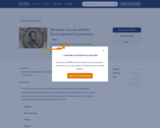
Presidents Buchanan, Lincoln, and Johnson believed that the Constitution protected the institution of slavery. Lincoln came to the conclusion that, in order to preserve the Constitution and the Union it created, he must apply a new understanding of the principles on which the nation was built. The time had come to bring the nationâ"s policies in line with the of the Declaration of Independence that "…all men are created equal…" In this lesson, students will analyze Abraham Lincolnâ"s views on slavery and the Constitution as evidenced in the Emancipation Proclamation.
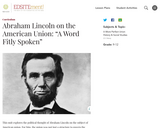
By examining Lincoln's three most famous speeches the Gettysburg Address and the First and Second Inaugural Addresses in addition to a little known fragment on the Constitution, union, and liberty, students trace what these documents say regarding the significance of union to the prospects for American self-government.
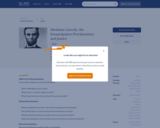
In this lesson, students will learn about Abraham Lincolnâ"s Emancipation Proclamation. Students will specifically learn about how Lincolnâ"s actions conform to the idea of justice and how they can apply this idea into actions in their own lives.
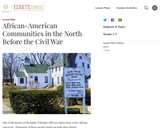
One of the heroes of the Battle of Bunker Hill was Salem Poor, an African American. Black people fought on both sides during the American Revolution. Census data also reveal that there were slaves and free Blacks living in the North in 1790 and after. What do we know about African-American communities in the North in the years after the American Revolution?

This lesson plan examines the events of the Bloodiest day in American History and helps students to understand the complexities of the event. Students will use the American Battlefield Trust Antietam 360 Virtual Tour to study certain moments of the battle and analyze how the natural and man-made environment affected the maneuvers, strategies, and tactics used during the battle as well as how these factors impacted the outcome of the battle.

This article examines the history of slavery in the United States leading up to the Civil War. This could be used as a teacher reference or it can be annotated with the class.
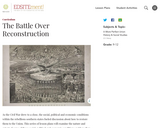
This curriculum unit of three lessons examines the social, political and economic conditions of the southern states in the aftermath of the Civil War and shows how these factors helped to shape the Reconstruction debate as well as the subsequent history of American race relations.

This lesson plan utilizes a video and question guide to help students understand the Civil War. The video breaks down the Civil war into short animated clips to help students understand the events of the American Civil War, and students learn by responding to a set of questions.

This video gives an overview of prisons during the American Civil War and how prisoners were treated. This resource is great for helping students understand the ordinary experience instead of only focusing on the generals and presidents of the time.
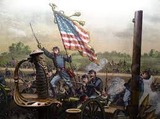
Students will be engaged in learning about American history prior and during the Civil War. They will be exploring historical documents and learning about the stories of people involved. They will then create a digitial story of what they learned to share with the class. Image attribution: Adam Jones from Kelowna, BC, Canada, CC BY-SA 2.0 <https://creativecommons.org/licenses/by-sa/2.0>, via Wikimedia Commons
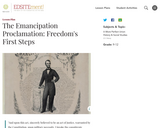
Why was the Emancipation Proclamation important? While the Civil War began as a war to restore the Union, not to end slavery, by 1862 President Abraham Lincoln came to believe that he could save the Union only by broadening the goals of the war. Students can explore the obstacles and alternatives America faced in making the journey toward "a more perfect Union."
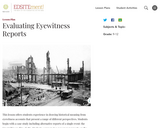
Practice working with elementary documents by comparing accounts of the Chicago Fire and testing the credibility of a Civil War diary.
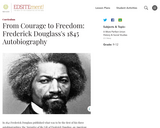
In 1845 Frederick Douglass published what was to be the first of his three autobiographies: the Narrative of the Life of Frederick Douglass, an American Slave, Written by Himself. As the title suggests, Douglass wished not only to highlight the irony that a land founded on freedom would permit slavery to exist within its midst, but also to establish that he, an American slave with no formal education, was the sole author of the work.
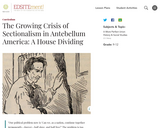
In this unit, students will trace the development of sectionalism in the United States as it was driven by the growing dependence upon, and defense of, black slavery in the southern states.

In this resource, students will engage with video clips that introduce students to the Gettysburg Address, highlight students of The Greenwood School analyzing the speech, and discuss the road to the Battle of Gettysburg and its impact on the war. Students will interact with these videos to learn about the Battle of Gettysburg and the significance of the Gettysburg Address. After viewing the curated clips, students will craft their own presentations analyzing the historical significance of a specific section of the Gettysburg Address with the goal of explaining to their peers what this section meant and why it is important.
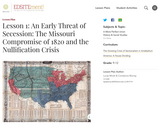
Americans affirmed their independence with the ringing declaration that "all men are created equal." Some of them owned slaves, however,and were unwilling to give them up as they gave speeches and wrote pamphlets championing freedom, liberty, and equality. So "to form a more perfect union" in 1787, certain compromises were made in the Constitution regarding slavery. This settled the slavery controversy for the first few decades of the American republic, but this situation changed with the application of Missouri for statehood in 1819.
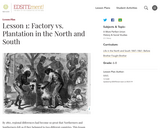
This lesson focuses on the shift toward mass production in northern factories and on southern plantations that occurred during the first half of the 19th century. Using an economics-focused approach to examining U.S. history prior to the civil war, students examine the role of slavery, industrialization, regionalism, and political responses that ultimately led to the start of a war.
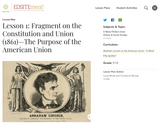
How did Abraham Lincoln understand the relationship between principles of the Declaration of Independence and the U.S. Constitution?